Mostrar el registro sencillo del ítem
dc.contributor.author
Garzón, Maximiliano Javier

dc.contributor.author
Jensen, Oscar

dc.contributor.author
Schweigmann, Nicolas Joaquin

dc.date.available
2018-02-26T19:04:04Z
dc.date.issued
2014-04
dc.identifier.citation
Garzón, Maximiliano Javier; Jensen, Oscar; Schweigmann, Nicolas Joaquin; Environmental factors related to the abundance and activity of ochlerotatus albifasciatus (Diptera: Culicidae) in an agricultural landscape of steppe arid climate; Entomological Society of America; Journal of Medical Entomology; 51; 4; 4-2014; 733-741
dc.identifier.issn
0022-2585
dc.identifier.uri
http://hdl.handle.net/11336/37139
dc.description.abstract
Ochlerotatus albifasciatus (Macquart) is a flood water mosquito whose highest density has been found associated both with natural landscapes (prairies or grazing fields) in temperate and subtropical regions and with rainfall events. In the current study, we aimed to find out how the marked differences between environmental factors of agricultural landscape patches in a steppe arid region affect the relative abundance of this species. In wetland patches, the high activity of adults was closely associated with the flood irrigation system, suggesting that the agricultural activity contributes to the proliferation of this mosquito. The steppe patches would constitute an adverse environment reflected by the abrupt decrease in abundance. Multiple linear regression showed that some explanatory variables, such as wetland patches and moment of the day (midday), did not contribute significantly to the relative abundance variation. In contrast, temperature, wind, and cloud cover seemed to regulate the biting activity of females. Temperature affected the activity of mosquitoes in the steppe but seemed to have no effect in wetland patches, where the activity of mosquitoes was permanent and more stable against changes in temperature. In the steppe, which presents low levels of humidity, scarce vegetation, and greater wind exposure, the activity seemed to be unstable against small thermal variations. The variability of the relative abundance of Oc. albifasciatus in an agricultural landscape was widely explained by temperature in combination with the microenvironment type, wind speed, and cloud cover and indirectly by human activity. © 2014 Entomological Society of America.
dc.format
application/pdf
dc.language.iso
eng
dc.publisher
Entomological Society of America

dc.rights
info:eu-repo/semantics/openAccess
dc.rights.uri
https://creativecommons.org/licenses/by-nc-sa/2.5/ar/
dc.subject
Activity
dc.subject
Anthropic
dc.subject
Booding
dc.subject
Steppe
dc.subject
Wetland
dc.subject.classification
Otras Ciencias Biológicas

dc.subject.classification
Ciencias Biológicas

dc.subject.classification
CIENCIAS NATURALES Y EXACTAS

dc.title
Environmental factors related to the abundance and activity of ochlerotatus albifasciatus (Diptera: Culicidae) in an agricultural landscape of steppe arid climate
dc.type
info:eu-repo/semantics/article
dc.type
info:ar-repo/semantics/artículo
dc.type
info:eu-repo/semantics/publishedVersion
dc.date.updated
2017-12-27T15:19:09Z
dc.journal.volume
51
dc.journal.number
4
dc.journal.pagination
733-741
dc.journal.pais
Estados Unidos

dc.journal.ciudad
Lanham
dc.description.fil
Fil: Garzón, Maximiliano Javier. Universidad de Buenos Aires. Facultad de Ciencias Exactas y Naturales. Departamento de Ecología, Genética y Evolución. Grupo de Estudio de Mosquitos; Argentina. Consejo Nacional de Investigaciones Científicas y Técnicas; Argentina
dc.description.fil
Fil: Jensen, Oscar. Provincia de Chubut. Secretaria de Salud; Argentina
dc.description.fil
Fil: Schweigmann, Nicolas Joaquin. Universidad de Buenos Aires. Facultad de Ciencias Exactas y Naturales. Departamento de Ecología, Genética y Evolución. Grupo de Estudio de Mosquitos; Argentina. Consejo Nacional de Investigaciones Científicas y Técnicas; Argentina
dc.journal.title
Journal of Medical Entomology

dc.relation.alternativeid
info:eu-repo/semantics/altIdentifier/doi/http://dx.doi.org/10.1603/ME14016
dc.relation.alternativeid
info:eu-repo/semantics/altIdentifier/url/https://academic.oup.com/jme/article-abstract/51/4/733/894561
Archivos asociados
